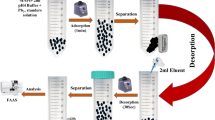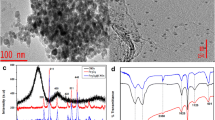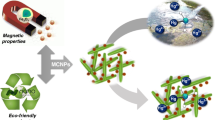Abstract
Magnetic partially carbonized cellulose nanocrystals (MPC-CNC) were obtained by sulfuric acid treatment of microcrystalline cellulose (MCC) and then loaded with magnetic Fe3O4 nanoparticles. The material is shown to be a viable material for magnetic solid phase extraction of triazine and triazole pesticides from water. The pesticides (specifically: simazine, ametryn, prometryn, terbutryn, atrazine, triadimenol, epoxiconazole, myclobutanil, triadimefon and tebuconazole) were quantified by ultra HPLC in tandem with a triple quadrupole mass spectrometry (UHPLC-MS/MS). The effects of NaCl concentration, amount of adsorbent, vortex time, sample volume and pH value on extraction efficiency were optimized by Plackett-Burman design and Box-Behnken design methods. Under the optimal conditions, the method shows the following figures of merit: (a) Linear responses in the range from 0.02–10 μg L−1; (b) detection limits between 2.2 to 6.1 ng L−1 (for S/N = 3); (c) recoveries from spiked samples of 73.7–117.1% with relative standard deviations (RSDs) of 2.0–15.7%; and (d) an enrichment factor of 75. The method was successfully applied to the determination of the pesticides in five environmental water samples.

Schematic representation of the process of magnetic solid phase extracting pesticides in water using MPC-CNC. MCC-microcrystalline cellulose; PC-CNC- partially carbonized cellulose nanocrystals; MPC-CNC-magnetic partially carbonized cellulose nanocrystals.






Similar content being viewed by others
References
Warne MSJ, King O, Smith RA (2018) Ecotoxicity thresholds for ametryn, diuron, hexazinone and simazine in fresh and marine waters. Environ Sci Pollut R 6:1–19
Liu X, Shen Z, Peng W et al (2014) Effervescence assisted on-site liquid phase microextraction for the determination of five triazine herbicides in water. J Chromatogr A 1371:58–64
Li X, Yu J, Li J et al (2017) Dopaminergic dysfunction in mammalian dopamine neurons induced by Simazine neurotoxicity. Int J Mol Sci 18(11):2404
Sai L, Liu Y, Qu B et al (2015) The effects of Simazine, a Chlorotriazine herbicide, on the expression of genes in developing male Xenopus laevis. B Environ Contam Tox 95(2):157–163
Silva M, Iyer P (2014) Toxicity endpoint selections for a simazine risk assessment. Birth Defects Res B 101(4):308–324
Taxvig C, Hass U, Axelstad M, Dalgaard M, Boberg J, Andeasen HR, Vinggaard AM (2007) Endocrine-disrupting activities in vivo of the fungicides tebuconazole and epoxiconazole. Toxicol Sci 100:464–473
Chen ZF, Ying GG (2015) Occurrence, fate and ecological risk of five typical azole fungicides as therapeutic and personal care products in the environment: a review. Environ Int 84:142–153
Najmeh Y, Mojtaba S, Mahnaz G (2019) Simultaneous extraction of 32 polychlorinated biphenyls by using magnetic carbon nanocomposite based dispersive microextraction, subsequent dispersive liquid-liquid microextraction with two miscible stripping solvents, and quantitation by GC-μECD. Microchim Acta 3:186–178
Naing NN, Yau SL, Lee HK (2016) Magnetic micro-solid-phase-extraction of polycyclic aromatic hydrocarbons in water. J Chromatogr A 1440:23–30
Sun Y, Tian J, Wang L, Yan H, Qiao F, Qiao X (2015) One pot synthesis of magnetic graphene/carbon nanotube composites as magnetic dispersive solid-phase extraction adsorbent for rapid determination of oxytetracycline in sewage water. J Chromatogr A 1422:53–59
Su H, Lin Y, Wang Z et al (2016) Magnetic metal-organic framework-titanium dioxide nanocomposite as adsorbent in the magnetic solid-phase extraction of fungicides from environmental water samples. J Chromatogr A 1466:21
Farajzadeh MA, Mohebbi A (2017) Development of magnetic dispersive solid phase extraction using toner powder as an efficient and economic sorbent in combination with dispersive liquid-liquid microextraction for extraction of some widely used pesticides in fruit juices. J Chromatogr A 1532:10–19
Zhang Y, Zhou H, Zhang ZH et al (2017) Three-dimensional ionic liquid functionalized magnetic graphene oxide nanocomposite for the magnetic dispersive solid phase extraction of 16 polycyclic aromatic hydrocarbons in vegetable oils. J Chromatogr A 1489:29
Roya R, Lahiji XX, Ronald R, Arvind R, Alan R, Robert JM (2010) Atomic force microscopy characterization of cellulose Nanocrystals. Langmuir 26(6):4480–4488
Arias A, Heuzey MC, Huneault MA et al (2015) Enhanced dispersion of cellulose nanocrystals in melt-processed polylactide-based nanocomposites. Cellulose 22(1):483–498
Ruiz-Palomero C, Soriano ML, Valcárcel M (2017) Nanocellulose as analyte and analytical tool: opportunities and challenges. Trends Anal Chem 87:1–18
Maatar W, Boufi S (2015) Poly (methacylic acid-co-maleic acid) grafted nanofibrillated cellulose as a reusable novel heavy metal ions adsorbent. Carbohydr Polym 126:199–207
Urruzola I, Serrano L, Llano-Ponte R et al (2013) Obtaining of eucalyptus microfibrils for adsorption of aromatic compounds in aqueous solution. Chem Eng J 229:42–49
Daniel B, Aji M, Kristiina O (2006) Optimization of the isolation of nanocrystals from microcrystalline cellulose by acid hydrolysis. Cellulose 13:171–180
Lu J, Jin RN, Liu C et al (2016) Magnetic carboxylated cellulose nanocrystals as adsorbent for the removal of Pb (II) from aqueous solution. Int J Biol Macromol 93:547
Zuin VG, Schellin M, Montero L et al (2006) Comparison of stir bar sorptive extraction and membrane-assisted solvent extraction as enrichment techniques for the determination of pesticide and benzo[a]pyrene residues in Brazilian sugarcane juice. J Chromatogr A 1114(2):180
Zhao G , Song S , Wang C, Wu Q., Wang Z. (2011) Determination of triazine herbicides in environmental water samples by high-performance liquid chromatography using graphene-coated magnetic nanoparticles as adsorbent. Anal Chim Acta 708(1–2):0–159, 155
Baugros JB, Giroud B, Dessalces G, Grenier-Loustalot MF, Cren-Olivé C (2008) Multiresidue analytical methods for the ultra-trace quantification of 33 priority substances present in the list of REACH in real water samples. Anal Chim Acta 607(2):191–203
Ye C, Zhou Q, Wang X (2007) Improved single-drop microextraction for high sensitive analysis. J Chromatogr A 1139(1):7–13
Mohd Marsin S, Hana Hassan A, Wan Aini WI, Aboul-Enien HY (2012) Dispersive liquid-liquid microextraction method based on solidification of floating organic droplet for the determination of triazine herbicides in water and sugarcane samples. Food Chem 133(2):557–562
Acknowledgements
This work was supported by National Natural Science Foundation of China (Contract Grant Number: 21307155, 21677175) and Chinese Universities Scientific Fund 2017LX001.
Author information
Authors and Affiliations
Additional information
Publisher’s note
Springer Nature remains neutral with regard to jurisdictional claims in published maps and institutional affiliations.
Electronic supplementary material
ESM 1
(DOCX 536 kb)
Rights and permissions
About this article
Cite this article
Yi, X., Liu, C., Liu, X. et al. Magnetic partially carbonized cellulose nanocrystal-based magnetic solid phase extraction for the analysis of triazine and triazole pesticides in water. Microchim Acta 186, 825 (2019). https://doi.org/10.1007/s00604-019-3911-x
Received:
Accepted:
Published:
DOI: https://doi.org/10.1007/s00604-019-3911-x




